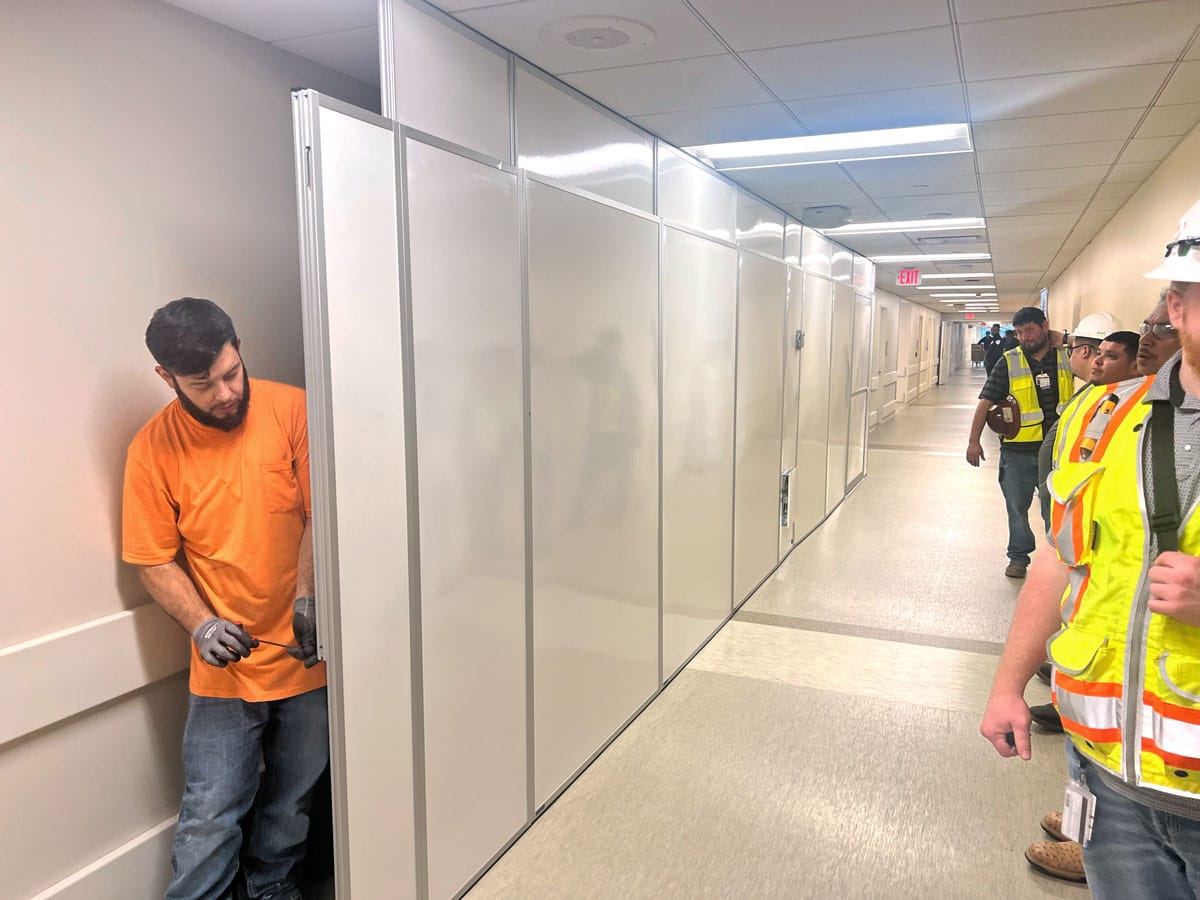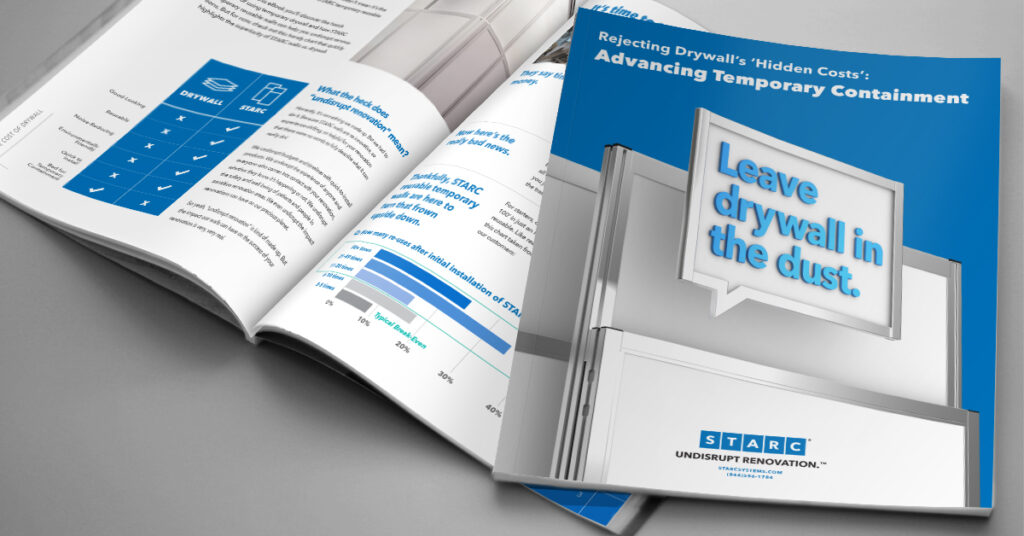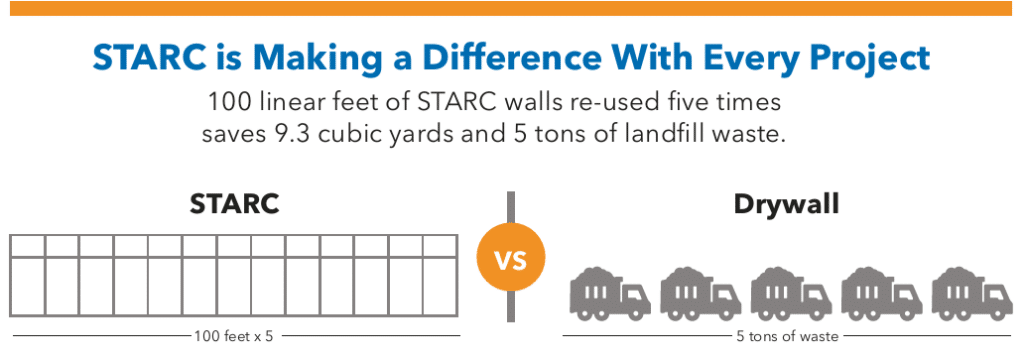
In an industry where speed and budget still dominate decision-making, sustainability has often been treated like a luxury—something to worry about later, or not at all. But with mounting pressure from regulators, investors, and tenants, that mindset is changing. Fast.
The Hidden Cost of ‘Business as Usual‘
Consider this: the U.S. generates over 600 million tons of construction and demolition debris every year, according to the EPA. A significant chunk of that waste comes from materials designed to be discarded, like temporary drywall and plastic sheeting used in renovation projects. It’s wasteful. It’s expensive. And in a world that increasingly values environmental stewardship, it’s also shortsighted.
But what if the most sustainable choice wasn’t the most expensive one? What if a smarter temporary wall system could reduce environmental impact and save time, labor, and money? That’s the promise of reusable temporary construction walls—a shift that’s better for the planet and the bottom line.
Why Sustainable Construction Is Now a Business Imperative
Sustainability has officially crossed over from buzzword to boardroom priority. Owners and developers are being asked to quantify their environmental impact. Project teams are being tasked with reducing waste. And Project and Facilities Managers? They’re increasingly seen as key players in delivering on ESG goals—whether they asked to be or not.
The pressure isn’t just top-down. Clients, especially in healthcare, tech, and education, are asking tougher questions about how their facilities are built and maintained. Landfill diversion rates. Carbon footprints. Life cycle costs. It’s all on the table now.
And there’s good reason for it. According to the Harvard Law School Forum on Corporate Governance, “Sustainability ROI extends beyond short-term financial gains…accounting for both tangible and intangible benefits.” From reputational equity to risk mitigation, companies that invest in smarter, more sustainable construction methods are reaping returns that extend far beyond the jobsite.
For Project Managers and Facilities Managers, this presents an opportunity—not just to comply, but to lead. Choosing durable, reusable containment systems is one of the most direct ways to make a measurable impact on both environmental outcomes and project economics. And in today’s environment, that’s exactly the kind of decision that gets noticed.

Learn the true cost of temporary drywall. Download our free eBook.
The Problem with ‘Disposable by Design’
Traditional methods for containing dust and debris—like drywall, plastic sheeting, and other single-use setups—are designed to be torn down and thrown away. That might have passed for “normal” in the past, but the cracks in that model are getting harder to ignore.
Drywall requires skilled labor, extended install time, and often off-hours work to avoid disrupting building occupants. Then it’s removed, trashed, and paid for again on the next job. Plastic sheeting and flimsy prefab options don’t fare much better—quick to install, sure, but also quick to fail when it comes to dust containment, noise control, or aesthetics.
The end result? A lot of wasted time. A lot of wasted material. And a missed opportunity to invest in something better.
Building for Reuse: How Modular Walls Flip the Equation
Reusability isn’t just a product feature; it’s a strategic approach to construction. Modular temporary wall systems that are designed for reuse bring the principles of the circular economy onto the jobsite. Instead of tearing down and throwing out containment materials after every phase or project, teams can install, remove, and reinstall panels over and over again.
This isn’t theoretical. STARC customers routinely report dozens—sometimes hundreds—of reuses per wall system. The performance remains consistent, the seals stay tight, and the aesthetics stay professional. It’s a modular solution that flexes to the needs of the project.
And the broader industry implications are enormous. According to the World Economic Forum, “Transitioning from a linear to a circular economy…could add up to $360 billion in extra net profits annually by 2050.” The construction industry is one of the largest consumers of raw materials and one of the biggest contributors to global waste. Small shifts toward reuse—like replacing disposable drywall with temporary wall systems—play a real role in reversing that trend.

Download Your Copy of STARC’s Sustainability Infographic
Sustainable Construction in Action: The Real ROI of Reuse
Reusable temporary walls don’t just feel good on paper—they deliver measurable returns in the field.
In real-world conditions, STARC wall systems can be installed at a rate of up to 100 feet per hour, drastically cutting down the time required for site preparation. This translates to earlier starts, fewer labor hours, and tighter project timelines.
And it doesn’t end with the install. Reusing those same 100 feet of wall panels across five projects can save up to 5 tons of drywall waste—that’s more than 9 cubic yards kept out of landfills. Multiply that by dozens of phases or locations, and the environmental impact becomes as substantial as the financial one.
According to ConstructEstimates.com, “Sustainable construction may present higher initial costs, but the long‑term savings make a compelling economic case.” That’s especially true when you compare cost-per-linear-foot over time. Many STARC customers find that their systems break even after just a few uses—and every reuse after that becomes pure savings.
The ability to redeploy walls across different spaces and job types also reduces dependencies on subcontractors, tool rentals, and emergency overnight drywall crews. And for project managers juggling phasing schedules and labor coordination, that kind of flexibility is priceless.

The ROI of Doing the Right Thing
Reusable containment systems don’t just reduce waste—they reduce friction across the entire renovation process. For one, they’re fast. Many systems can be installed four times faster than drywall, helping teams start earlier and phase projects more efficiently. They also reduce dependencies on skilled trades, which frees up labor for more specialized tasks.
More importantly, they’re built to be used again. And again. And again.
According to STARC customer data, walls are frequently reused 50+ times, helping contractors and facilities teams avoid not only repeat material costs but also the labor, haul-away, and landfill fees that come with traditional tear-down methods. That adds up to a significant reduction in both total project cost and carbon footprint.
And it’s not just about savings—it’s about strategy. Companies that embrace reusable, adaptable infrastructure are better positioned to meet evolving code requirements, client expectations, and ESG reporting frameworks. In a market that increasingly rewards long-term thinking, investing in solutions that align with both profitability and sustainability isn’t just responsible—it’s smart business.
And unlike other green building investments that may take years to pay off, this one starts delivering after just a few uses.
TL;DR – 5 Reasons Reusables Win
Conclusion: A New Standard for Temporary Doesn’t Feel Temporary
It’s no longer enough for a construction solution to be fast or affordable. Today’s jobsite demands more—more durability, more flexibility, more sustainability. Reusable temporary wall systems check all three boxes, while offering an ROI that goes beyond the balance sheet.
Whether you’re managing budgets or building an ESG strategy, containment might seem like a small detail. But it’s often the first and last thing occupants see during a renovation—and one of the easiest places to make a smarter choice.
Sustainable construction doesn’t require a massive overhaul. Sometimes, it just takes a better wall.
Ready to cut waste and costs on your next project?
→ Download the eBook: Rejecting Drywall’s Hidden Costs
→ Explore the Sustainability Infographic
→ Talk to a Temporary Wall Expert
